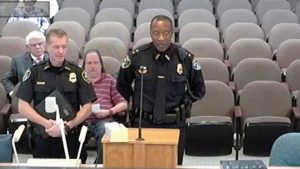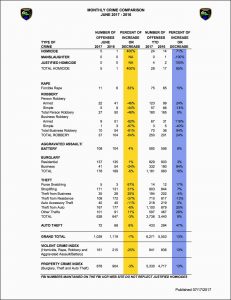Crime occupies a growing share of our collective civic attention in Shreveport in 2017. This is in no small part due to a number of high-profile cases concerning popular and respected community members and businesses. Coupled with the general “tough on crime”, law and order focused rhetoric and policy push (demagoguery and fear mongering, some may say) of politicians at all levels of government, the effect is, described charitably, a graying of the zeitgeist in our city. There is evidence of waning confidence in our local law enforcement’s ability to respond to the challenges of public safety with proven, modern and proactive strategy. Though much of this evidence is anecdotal and traded informally, it is a reflection of a shared belief that criminal activity is more pervasive than in recent times. A cursory glance at neighborhood message boards and Facebook groups (an act I STRONGLY suggest you not undertake) demonstrates: people are scared, weary, and anxious in Shreveport.
 That said, it is crucial that a community preserves a sense of perspective, especially when such fraught civil concerns like tax expenditures, investment attractiveness of the region, schools, and public safety. To be sure, criminal activity should always be confronted. Demands for increased accountability from law enforcement authorities, reinvestments in our education systems and social infrastructure, and pursuits to bring lawbreakers to justice, are not mutually exclusive; a community can do them all simultaneously. The most efficacious, humane, and lasting crime reduction strategies must, as a minimum, recognize and respect the intersectionality of social problems (poverty, mental illness, and good old-fashioned bigotry to name but a few). The issues are complex, the resources and dollars are few, and police departments everywhere are asked to perform an increasingly difficult task with less at every budget cycle. (These issues are worthy of separate treatment at another time.)
That said, it is crucial that a community preserves a sense of perspective, especially when such fraught civil concerns like tax expenditures, investment attractiveness of the region, schools, and public safety. To be sure, criminal activity should always be confronted. Demands for increased accountability from law enforcement authorities, reinvestments in our education systems and social infrastructure, and pursuits to bring lawbreakers to justice, are not mutually exclusive; a community can do them all simultaneously. The most efficacious, humane, and lasting crime reduction strategies must, as a minimum, recognize and respect the intersectionality of social problems (poverty, mental illness, and good old-fashioned bigotry to name but a few). The issues are complex, the resources and dollars are few, and police departments everywhere are asked to perform an increasingly difficult task with less at every budget cycle. (These issues are worthy of separate treatment at another time.)
Be this as it may, the citizenry has a responsibility to vigilantly and critically consider the media coverage and attention paid to crime. As is well understood, “if it bleeds, it leads” governs the editorial decision-making of nearly all of our local newscasts and print outlets. More eyeballs generate more advertising revenue, and the competition for viewers and readers is as fierce as ever. So with the understanding that, to some degree, media’s crime coverage is motivated by the financial bottom line, let’s take a short look at crime statistics in Shreveport over the last couple of years.

An opening caveat: this examination is not deep, and is likely based in statistical analysis no more so than the average unhinged Facebook rant (again, DO NOT seek out said rants). Perception is reality, however, and feelings aren’t dependent on statistical justification. We hope, nonetheless, to at least give voice to a few other useful discussion points concerning crime in our neighborhoods.
First, it may be the case that crime is, relative to other categories of news, overreported. Between the repetition of local crime news across print, radio and television, and the reinforcing drumbeat from national media sources, it seems that shootings, burglaries, and other forms of mayhem consume an outsized chunk of attention. The keyword here is “seems”; this examination offers no measurement to confirm or deny this contention, but offers that few would disagree with the conclusion, even if based solely on its truthiness.
Second, the city of Shreveport does produce and make publicly available month-by-month citywide crime stats. They can be found here. By looking at the Crime Comparison reports for June 2016 versus June 2015, and for the same months in 2017 and 2016 respectively, a snapshot of the larger trends emerges. For example, year-to-date totals for homicides in Shreveport through the month of June in 2016 are 17, roughly 3 a month citywide. For the same period in 2015, the total is 11, or roughly 2 a month. While this represents a 55% increase year-over year, big jumps in percentages are typical when dealing with relatively small numbers to begin with. Any number of murders is too big, to be sure, but preserving a sense of relative scale is useful, and responsible. For 2017 vs. 2016, the raw figure for total homicides over the same time period jumps from 17 to 28, representing an increase of 65%. Again, statistically significant, but perhaps only barely so. Importantly, within the 2017 totals through June, there is a 100% increase in the number of homicides that were ruled “justifiable”.
An examination of the same timeframe for criminal category “Burglary”, there is a reported 6% decrease from 2015 to 2016, as compared to a significant but not astronomical 18% increase from 2016 to 2017. For the subcategory of “Person Robbery Armed”, the percentages in the same time frames reflect a 6% decrease following by a 24% increase, with raw figures of 105, 99, and 123. Again too many regardless, but smaller baseline figures will always lead to larger percentage jumps as the raw totals move. Such is the nature of mathematics.

As a backdrop to all of this, 2014 saw the lowest crime rate in Shreveport in 4 decades. Surely, this is little comfort to the victims of crime, or to the families and friends of those killed and injured.
Governance and public policy cannot be predicated on popular sentiment only, much less on partial understandings, truthiness or hysteria.
The still new Shreveport Chief of Police Alan Crump’s recently rolled out plan to attack violent crime in Shreveport, unfortunately titled “Operation Shots Fired” (seriously…), which, while having produced some results, in no small part employs antiquated and discredited policing tactics, relies on increases in citizen reporting “tip line” participation and (most cynically, but unsurprisingly) prayer vigils. See the document for Chief Crump’s overarching strategy here.

On August 8th, Chief Crump presented the first report of results Operation Long Haul to the Shreveport City Council. The results are far from encouraging. After an additional 500 hours of overtime expended by a 10-person detail from July 6th to August 5th, Long Haul brought in 11 felony arrests, 60 traffic tickets, and maybe a couple thousand dollars of narcotics, half of which was pot. Back-of-the-napkin arithmetic, and a conservative assumption that the operation of this detail has a run rate of $100 per man-hour, we can conclude that SPD spent a bit over $4,500 per felony arrest. That seems like a huge figure for what amounts to a few personal stashes and some disregarded stop lights. The City Council must demand regular updates from the Chief, and press for improvement in these numbers. Strikingly, a few members of the City Council actually praised this performance at the time. Here’s video of Crump’s appearance, starting at about the 1 hour 32 minute mark.
Crime adapts. Now the the element of surprise is largely spent, and the result of a few weeks is so meager, we should try to stay hopeful that Chief Crump and Operation Long Haul can quickly make some leaps in efficiency and effectiveness, swiftly. We advise everyone to regard crime reporting, and all reporting in aggregate, with a dash of skepticism. Stay mindful of the shortcomings of big percentages and unexamined statistics. And of course, do all that you can to make sure you and your loved ones, neighbors and friends avoid becoming victims.



